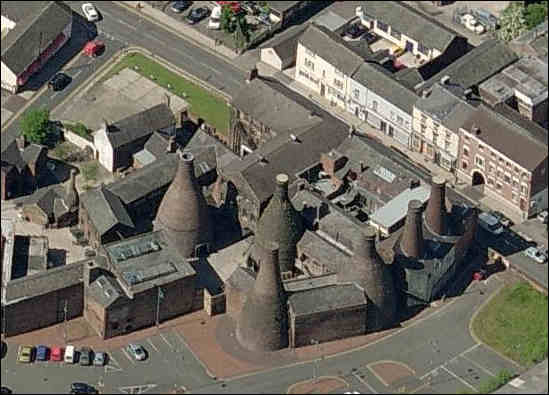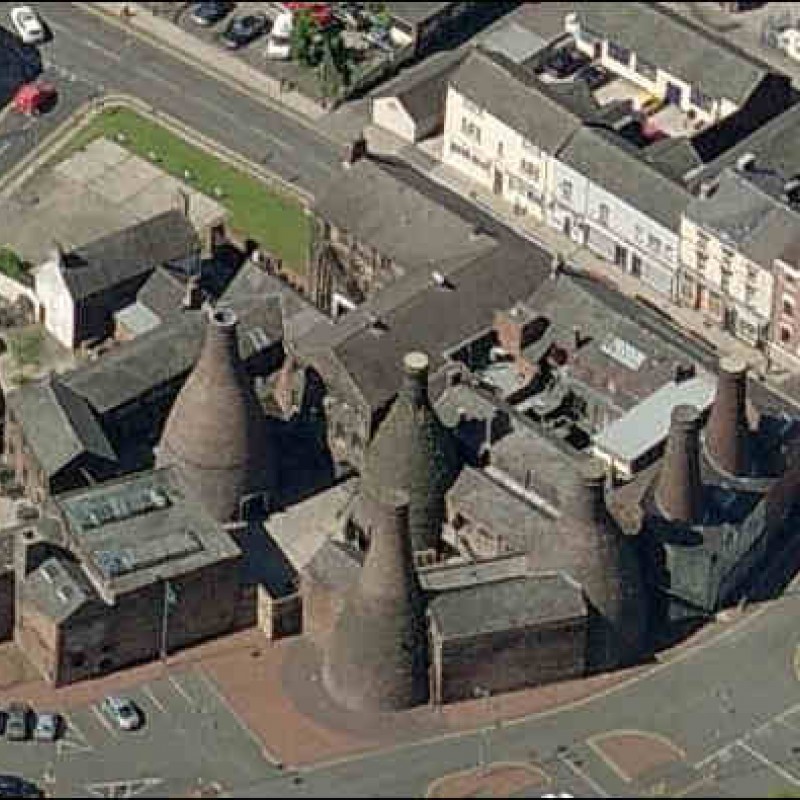Gladstone Pottery Museum
Uttoxeter Road,Longton,Stoke-on-Trent,ST3 1PQ, United Kingdom
| Former Use: | Bone china tableware factory |  |
| New Use: | Industrial Museum | |
| Category: | Industrial Museum | |
| Website: | http://www.stokemuseums.org.uk/gpm/visit/ | |
| Original Architect: | - | |
| Reuse Architect: | - | |
| Construction year(s): | 1774 - 1939 | |
| Reuse year(s): | 1974 - |
Description:
1770s-1869 Growth of an industry
Land larger than the current Gladstone site was bought from the Lord of Longton Manor by two brothers, Thomas and Michael Shelley, who operated two factories jointly. They produced creamware, the typical Potteries product of that time. In 1815 the site split and the Gladstone Portion had a house, small workshops and one bottle oven, maintaining a separate history from that point. It had one owner until 1857, but was let out to a succession of tenants who made bone china in step with the trend of that time. For this change it expanded from a small one-oven works dependent on other factories to a self contained three oven factory. An entrepreneurial tenant, later owner, Thomas Cooper expanded the workshops in the 1850s, and built an imposing main road frontage in the classical style. This replaced the old fashioned master’s house, providing warehouse space and a main street frontage for which could generate rental income from smaller retail businesses. The boundaries of the Historic Factory were established.
1869 – 1939 – A family concern, and Gladstone got its name
The site was owned by successors of one family, who called their works Gladstone Pottery after the well loved Prime Minister. The ‘mill’ current engine house was built about 1875, as a two storey building with a pitched roof, in the typical Potteries style. It housed a steam engine which powered grinding pans on the first floor for grinding raw materials. It also would have powered steam jiggers and jolleys on site. Steam engines were introduced in the 1870s when child labour was becoming less available. Few other changes were made to the site, the pottery industry went through booms and slumps, little money was available for investment and the workshops behind the grand frontage were ageing, and in a poor state of repair. A detailed inventory of the site in 1910 gives a snap shot of uses and fittings for that date, which oral histories tell us had changed very little up to 1939.
1939 – 1971
The factory closed down production during the war period being ‘concentrated’ with Thomas Poole (Longton) Ltd, members of the Poole family being Directors of Gladstone China. After the war repairs were needed to get the factory operational again and much repair work was done to the kilns. Thomas Poole (Longton) Ltd took over the factory in 1950 which was a boom time for the industry and prepared to expand purchasing the buildings of the Doctor’s House, White House, and the company Salisbury China.
The Clean Air Act forbidding the use of coal fired bottle ovens, probably led to investment being concentrated on Thomas Poole’s main factory – the Cobden Works. In March 1960 the bottle ovens were fired for the last time, but decorating and then only despatch departments were active until May 1970 when Thomas Poole and Gladstone China Ltd put the works up for sale.
1971 – 1974 Saved and reborn
During the 1960s when so many of the old pottery factories and bottle ovens were being demolished there was a group of local people, centred on the Trustees of the Cheddleton Flint Mill, who were interested in saving part of the traditional distinctive Stoke-on-Trent landscape. Many sites were considered but the Gladstone site was considered the best example of a medium sized typical potbank. When the factory was due to be demolished to make the site more attractive to purchasers, a local businessman, Derek Johnson of H&R Johnson the tile manufacturers, bought the site and transferred ownership to the Staffordshire Pottery Industry Preservation Trust to be run as a museum opening in 1974. The city of Stoke-on-Trent took ownership of the site in 1989, and took over management of the museum in 1994. (1)
Relevant Literature:
- http://www.stokemuseums.org.uk/gpm/history/
- Stratton, M. 2003. Industrial Buildings: Conservation and Regeneration, London, Taylor & Francis, 185
- http://www.thepotteries.org/listed/97a.html
